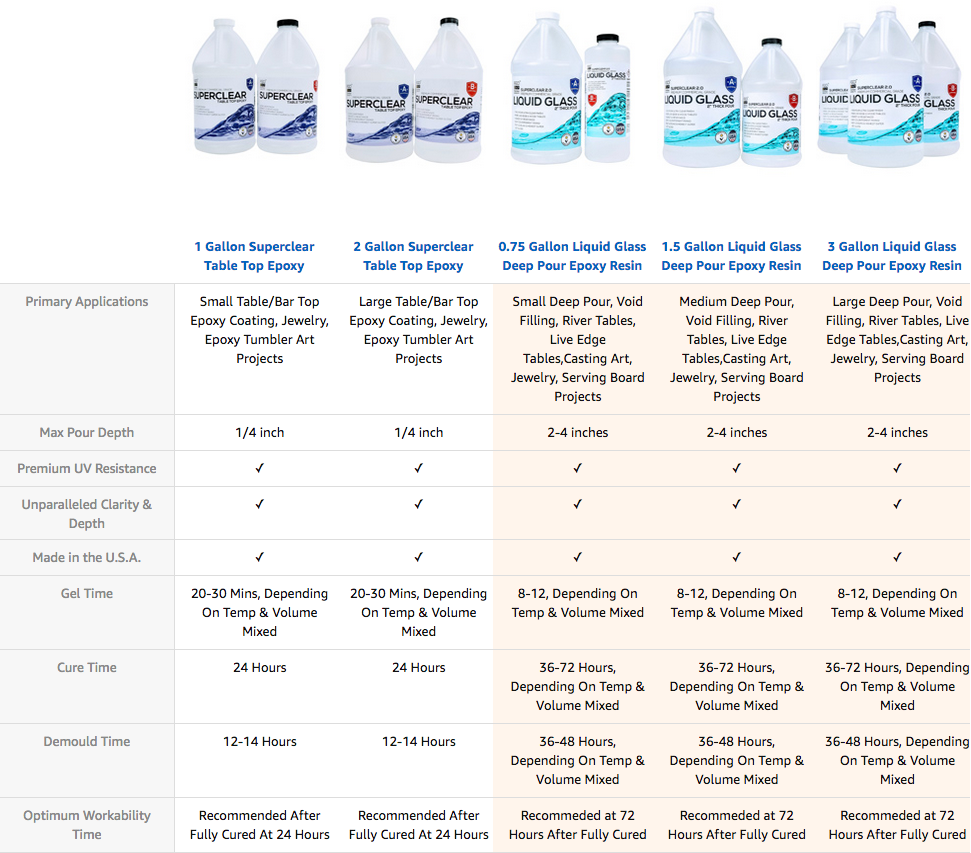
Liquid Glass® Directions:
STEP 1:
Using the Coverage Chart, determine the amount of epoxy you will need for your project. Be sure to order Superclear® Table Top Epoxy for a seal coat to ensure best results!
STEP 2:
Ensure your working environment is clean, dry and at least 70 degrees for best results. Lay down a plastic sheeting below your project for a safe, easy cleanup. Make sure your surface is completely level, as the epoxy will self-level.
STEP 3:
Seal Coat – Be sure to clean the surface with Isopropyl Alcohol 90% + and apply your sealcoat with a brush, following all mixing directions for that product. Let it get tacky before pouring your deep pour. If the seal layer is fully cured, for best results, lightly sand the surface with 320 grit sandpaper and clean with Isopropyl Alcohol 90% +, and then pour the deep pour.
STEP 4:
Mixing Deep Pour – Measure 2 parts Resin to 1 part Activator and pour into a clean, dry bucket or cup. Stir the mixture for at least 5 minutes with either a stir stick (if mixing with a stir stick, do not mix more than 1 quart) or a drill mixer set to low. Ensure you are not whipping air into your epoxy. Be sure to scrape the sides and bottom to ensure all of your epoxy is properly mixed.
STEP 5:
Transfer contents to a new, clean, dry bucket or cup and continue mixing for 3 more minutes to ensure proper mixing, again scraping sides and bottom.
STEP 6:
Pour mixture directly into your mold at your desired depth. Do not scrape the bucket at this time. If you do, you risk scraping in unmixed material that has clung to the sides or bottom. This would result in soft spots and/or hotspots.
STEP 7:
Use a heat source, like a heat gun to remove any air bubbles. Start at 6” minimum above the surface and sweep back and forth until no bubbles remain. Do not leave the heat gun over the surface too long, if you do, it may result in surface distortions.
STEP 8:
Allow the surface to cure, up to 72 hours in a dust-free environment. The epoxy will start to get tacky after 24 hours but do not disturb for 72 hours to ensure a proper cure.
PRO TIPS
- If you wish to apply paper decals or other objects under the SuperClear® 2.0 surface, those objects need to be bonded to the surface either with Superclear® Epoxy or craft glue. Some wood may take the material well in a single coat; however, many types of wood require a seal coat to prevent air bubbles from rising out of the wood and ruining the surface. Older, more porous pieces of wood may contain both air and moisture that can contaminate the finish. In this case, the user may first paint on a very thin coat of Superclear® Table Top Epoxy, allowing that to set before pouring the new layer.
- The larger the pour, meaning the more epoxy volume, the more attention needs to be paid to the overall heat being given off by the epoxy.
- Use saw horses or 4×4’s to raise your mold off of a flattened surface. This prevents that flattened surface from adding extra insulation to your mold, therefore keeping heat in when the epoxy needs to be kept at a cool stable temperature. This also allows for airflow underneath your mold, wicking away unwanted heat. This prevents unwanted outcomes like cracks and trapped bubbles.
- Use an oscillating fan to help wick away heat from the top and evenly distribute that heat, thus assisting in keeping that epoxy at a stable temperature.
- Do not over-clamp your wood substrate to your mold. Doing so will create an immovable object and prevent the substrate from having the necessary ability to slightly shift with the epoxy as it cures. Make sure to only clamp the substrate down to keep it from floating up vertically, but not prohibiting it from shifting horizontally.
Frequently Asked Questions
HOW LONG DO I HAVE TO MIX IT?
– You need to stir it by hand for a minimum of 5 minutes, scraping the sides and bottom thoroughly throughout while mixing. When pouring, we do not recommend scraping the sides. Doing so can risk mixing in unmixed, unincorporated epoxy into your pour, thus creating curing issues.
HOW THICK CAN I POUR IT?
– You can pour up to 4” thick per pour, depending on ambient temperature and total mass. Much thicker than most competitors! The mass for a 4” pour varies depending on temperatures and conditions. If you have never poured a deep pour at 4”, we suggest you try it on a smaller scale to understand how it will cure in your particular environment.
HOW LONG DOES IT TAKE TO CURE?
– The product will begin to harden within the first 12-24 hours in ideal conditions, but takes 48-72 hours to completely cure, depending upon conditions like constant temperature, humidity, mass and airflow.
CAN I ADD ANOTHER LAYER TO THE SURFACE?
– Yes! Simply wait until the pour is tacky and nearly hard and pour your next layer. If the product is already hard, lightly sand with 220-320 grit sandpaper and wipe it down with Isopropyl Alcohol 90% or higher before adding additional layers, which helps with the adhesion between the two layers.
CAN I CLAMP DOWN MY WOOD TO PREVENT IT FROM FLOATING?
– While you can clamp down your wood during a deep pour, be sure not to clamp it too tightly. As the epoxy cures, the wood needs some room to flex while it turns from a liquid to a solid. Without room to flex, pressure will build in the epoxy, resulting in stress, increased heat, and even cracking. To avoid this, only finger tighten your C-Clamps or use light enough weights to keep the wood from floating.
